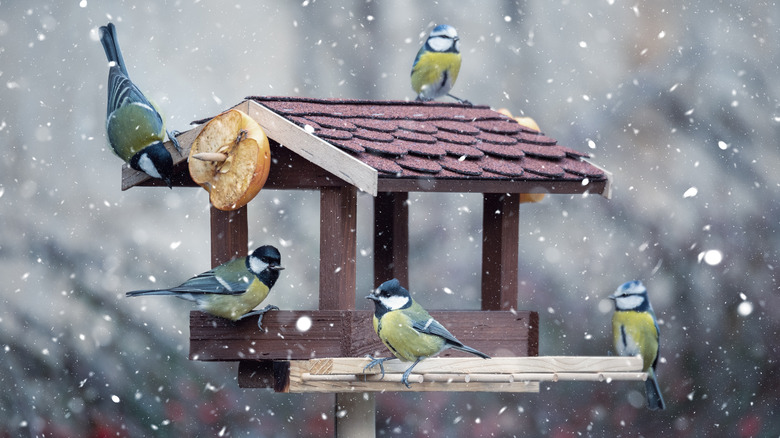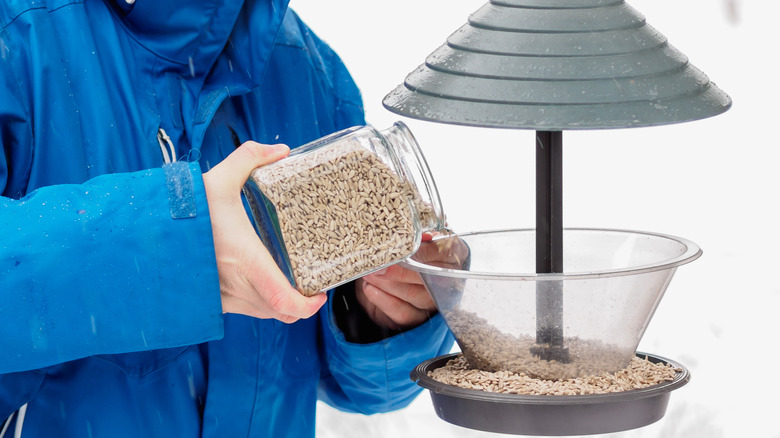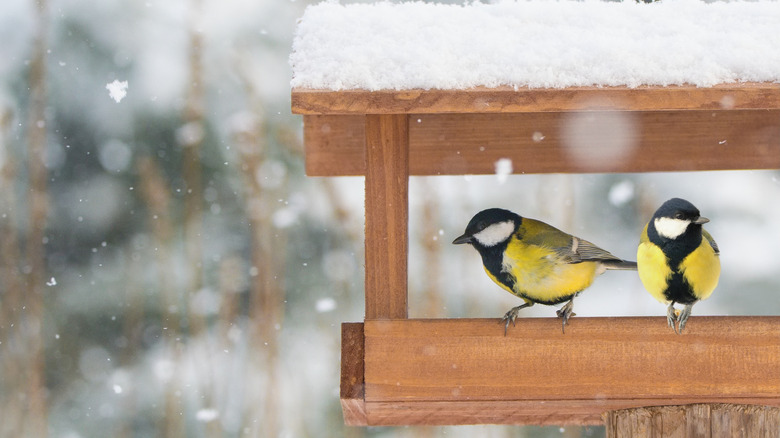What To Do With Your Bird Feeder In The Winter
Many birds don't fly south for the winter. Instead, they stay close to home, and during the colder months when food is less readily available, providing a bird feeder for them to use is beneficial. However, there are a few things to do with your bird feeder in the winter to keep your feathered friends healthy, including keeping it clean and refilled consistently.
Depending on where you live, you'll likely notice birds like bluejays and cardinals still around during the winter months. Most birds will reduce their activity significantly in the winter to maintain their higher weight and insulation against the cold temperatures. In late winter, when food sources are much lower, or the temperatures are very cold, it's quite helpful to provide some food for birds even though they don't need as much energy as they do in the summer months. And if your birdfeeder has long been a food source for them, it should continue to be well into the winter months.
To provide ultimate support for birds during the winter, you'll want to up the game in terms of the type of food you're feeding them. You also should provide a fresh source of water that you change out often. You'll need to watch for a few common problems that could make the feeder far less accessible to the birds.
Keep your bird feeder filled in the winter with the right foods
Your birds may depend on your bird feeder, especially if they've used it throughout summer and fall. However, their needs may change a bit during this time of the year. Provide birds with a high-fat diet, such as with lard or nuts on a suet block or seeds like black sunflower seeds, black oil sunflower seeds, or simply a mix of seeds. You can also give them organic fruit and even a bit of cheese (they prefer grated, mild forms of cheese). To provide more protein, look for bird food that includes mealworms, which is something that's likely to help woodpeckers and cardinals. Most birds appreciate cracked corn, and if you have a wide range of birds to feed, consider using a peanut butter-type feeder.
Monitor the bird feeders on a consistent basis to note what's happening at them. For example, you may want to consider a bird feeder camera that allows you to see what type of birds are making their way to your home, allowing you to adjust what you feed them if you really want to be specific. You can continue to use the same bird feeders you've used all year, but you may want to add in suet if possible. A suet bird feeder provides a high-fat, high-energy diet that can help dependent birds get the calories they need at this time of the year.
Make sure to maintain your bird feeders
While keeping them full is important, you also need to maintain and clean the feeders properly during the winter months. Keep the feeders free of any snow or ice buildup since that can limit access to the bird food during critically cold spells. You also want to ensure that all openings are free from debris, snow, clumps of frozen food, or anything else that limits access. Whenever temperatures drop and there's rain, sleet, or snow, make it a point to check your bird feeders. If you have a feeder that has a larger cover or overhang on it that covers the perches and food trays, that will help protect the food from moisture to some degree.
It's also a good idea to clean the space around the feeder on the ground. Many birds who cannot balance on the feeder themselves may attempt to pick up the fallen debris from other birds. Removing the snow from this area under the feeder also gives birds a place to eat if branches are snow-covered. However, you don't want to place the feeder on the ground itself or use a platform-style feeder, as that's going to bring in unwanted pests. Whenever necessary, remove the feeder and wash, sanitize, and replace. Avoid any broken feeders, too, since sharp areas of plastic can be dangerous. If you have persistent deer or other pests, consider fencing in your yard or feeder for added protection.


